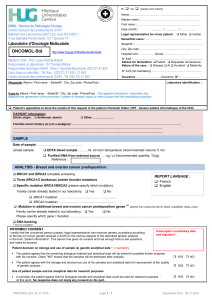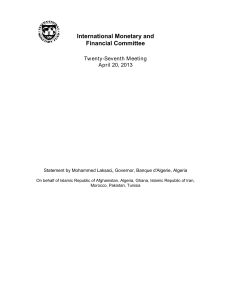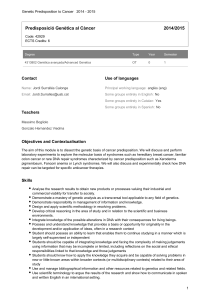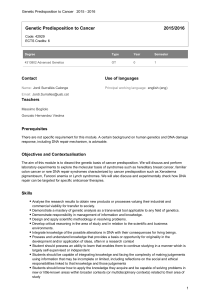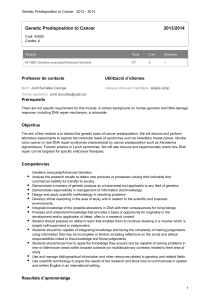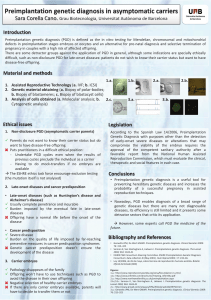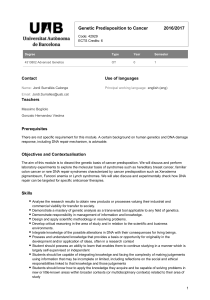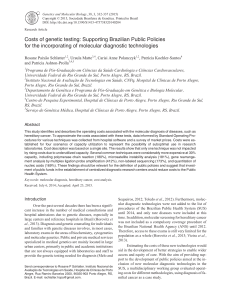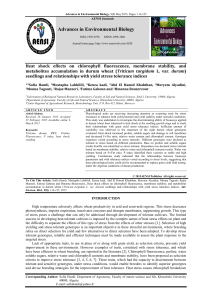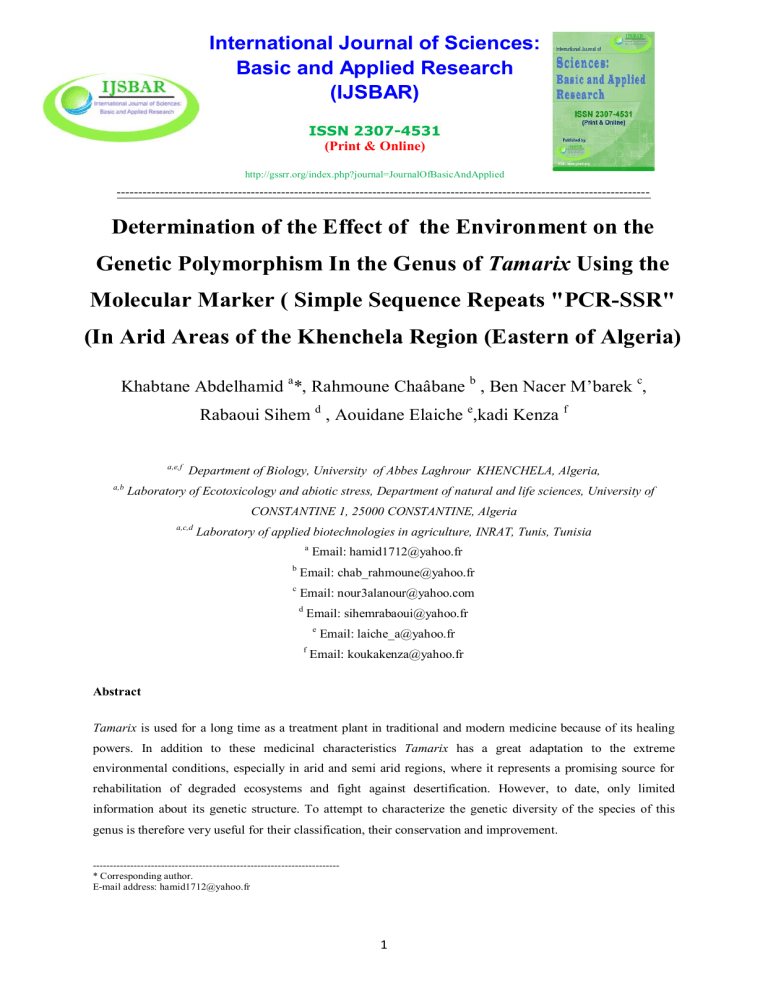
International Journal of Sciences: Basic and Applied Research (IJSBAR) ISSN 2307-4531 (Print & Online) http://gssrr.org/index.php?journal=JournalOfBasicAndApplied --------------------------------------------------------------------------------------------------------------------------- Determination of the Effect of the Environment on the Genetic Polymorphism In the Genus of Tamarix Using the Molecular Marker ( Simple Sequence Repeats "PCR-SSR" (In Arid Areas of the Khenchela Region (Eastern of Algeria) Khabtane Abdelhamid a*, Rahmoune Chaâbane b , Ben Nacer M’barek c, Rabaoui Sihem d , Aouidane Elaiche e,kadi Kenza f a,e,f a,b Department of Biology, University of Abbes Laghrour KHENCHELA, Algeria, Laboratory of Ecotoxicology and abiotic stress, Department of natural and life sciences, University of CONSTANTINE 1, 25000 CONSTANTINE, Algeria a,c,d Laboratory of applied biotechnologies in agriculture, INRAT, Tunis, Tunisia a b c Email: [email protected] Email: [email protected] Email: [email protected] d Email: [email protected] e f Email: [email protected] Email: [email protected] Abstract Tamarix is used for a long time as a treatment plant in traditional and modern medicine because of its healing powers. In addition to these medicinal characteristics Tamarix has a great adaptation to the extreme environmental conditions, especially in arid and semi arid regions, where it represents a promising source for rehabilitation of degraded ecosystems and fight against desertification. However, to date, only limited information about its genetic structure. To attempt to characterize the genetic diversity of the species of this genus is therefore very useful for their classification, their conservation and improvement. -----------------------------------------------------------------------* Corresponding author. E-mail address: [email protected] 1 International Journal of Sciences: Basic and Applied Research (IJSBAR) (2014) Volume 16, No 2, pp 1-10 In this context, we started in the assessment of the level of genetic diversity characterizing Tamarix pushing currently in Algeria and in which they are originate. we used the PCR-SSR of 23 genotypes selected from three very different sites (en perspective of climate, edaphic and orographic conditions), through the arid regions of Khenchela in eastern of Algeria. The results are obtained by the highlighted amplification of 14 primers specific for Tamarix. Analysis of the results using the software TreeCon for Windows, at a threshold of dissimilarity of 50% we have obtained nine distinct groups, in general, the results showed a high level of genetic divergence within and between species among genotypes, with relevant remarks in four accessions, (II 2, II 10, III 3 and III 9), of the ninth group who have not shown any genetic variation linked to the species or to the environment. Keywords: Tamarix; arid regions; genetic polymorphism; PCR-SSR; Khenchela; Algeria 1. Introduction The Tamarix is one of four genera of the family of Tamaricaceae, containing more than 80 species whose are native to Eurasia and North of Africa [1]. There is more than 14 species and subspecies of Tamarix in Algeria whom are determined in the new flora of Algeria Quezel [2]. The Tamarix has been known since antiquity for its therapeutic characteristics, and is even used as an anti-carcinogen plant in traditional medicine among the peoples of the Maghreb [3]. The Tamarix is distinguished by its high ubiquity and ecological resistance, where it can tolerate to the most of extreme environmental conditions such as drought, salinity, cold etc.. [4]. Those characteristics make from Tamarix a promising shrubby plant for the rehabilitation of ecosystems and the fight against desertification in arid and semi-arid, where Algeria including more than 80% of the lands [5]. However, the mechanisms of adaptation and genetic structure of the genus of Tamarix are not known, which is the case of many Mediterranean species, few studies have brought on the assessment of genetic diversity, which is the necessary knowledge for good management and development of the plant genetic resources [6]. This study contributes to the identification of the effect of the environment on the genetic variability of the genus of Tamarix. To do so we opted for the technique molecular marker (PCR-SSR) of 23 accessions of different species of the genus of Tamarix, using 14 specific primers for Tamarix. The genotypes were collected from three very different sites in climatic, edaphic and orographic levels and distributed along a south-north transect in arid zone of Khenchela which is located in eastern Algeria. 2. Materials and Methods 2.1. Plant material and test sites Samples of Tamarix species studied were collected from three different sites (Site I (Shott), Site II (Oued (River)) Site III (Desert)) from the arid zone of Khenchela in eastern Algeria (Figure 1 and 2). We selected at random 30 samples consisting of young leaves of 10 adult individuals for each site. 2 International Journal of Sciences: Basic and Applied Research (IJSBAR) (2014) Volume 16, No 2, pp 1-10 Figure 1: Panoramic view of the study's sites 3 International Journal of Sciences: Basic and Applied Research (IJSBAR) (2014) Volume 16, No 2, pp 1-10 Figure 2: The geographical position of the region of Khenchela and distribution of study's sites 2.2. Extraction and quantification of the DNA Genomic DNA was extracted from young leaves using the cetyltrimethylammonium bromide (CTAB), by grinding in liquid nitrogen, using the method described by [7,8]. The different samples purified DNA was resuspended in 100μl of TE buffer solution. The DNA concentration was monitored by quantification performed on 0.8% agarose gel. 4 International Journal of Sciences: Basic and Applied Research (IJSBAR) (2014) Volume 16, No 2, pp 1-10 2.3. Primers used We tested 30 genotypes with 14 specific primers of Tamarix, because of the quality of polymorphic bands they produced, we selected 23 genotypes whom gave a good results (Table 01). Table 1: the primers used and genotypes selected to SSR markers Primer Séquence F:TTGGCTGTTGAAGAAGATCG Th127 Repeat Ta Motif (C ° ) (AGG) 4 58 R:TCTCCAAACCTTGACCGACT F:TACCTTGCGAACACAACTGC Th321 R:TACACCGAGAGAGACGCTGA Ta201 F:AATTTGTCCGACTCCACTGT Good results' Génotypes Site I Site II Site III I 1, II 1, III 3, I 2, II 2, III 4, (CTC) 6 58 I 3, II 3, III 5, (AT) 7 56 I 4, II 4, III 6, (AG) 11 58 I 5, II 6, III 8, (AG) 10 54 I 6, II 8, III 9, I 7, II 10. III 10. R:CGTCTCCTTTTCAGGCGTAG Th412 F:CTGGCAAGTAGCAACACCTCT R:GGATGAACAACCCAACCATC F:ACGTGGTTTGGTGAAAGGAG Th715 R:CCACCCTTAACCCACTCAGA F:CGCTCTGTTGATCATCTTCG Th1071 58 I 8, (GA) 7 57 I 9. (AAG) 6 58 (CCTGCT)4 58 (CATC) 4 58 (ATG) 11 57 (TTA) 6 54 (ATG) 11 58 R:TGTCCCAATCCGTTACAAAA F:CATGGCAGTGATGGATTCAG Ta1350 (TTTC) 4 R:GGACAGTTCAGCCTCCACAT F:GTTGAGCAGCAATCACATGC Th2620 R:GAAGGGGCAGTGTTTTTCAA Th2876 F:CTGTAGCCAAGCATGGGACT R:AAGACACGTAAACCCGCAAC F:TCAGATTTTGCAAACCACCA Th3484 R:AAGCCTTTGCATACCACCAC F:GCCGAATTTTGTTGTGGATT Th5990 R:AATAAAAGGCACCCTCATCG F:TCGGATTCTGGAAGGTGTTT Th6387 R:TGCAACGAAAACATTATTACCC F:CCGTGGACTAACCTTGCCTA Th6976 R:CAAGCAAACGCAGGGTAGAT 2.4. DNA amplification and electrophoresis Amplification was performed in a total volume of 25μl according to the Protocol of Gaskin [9], [10] containing: - 2μl of DNA extract (10ng/μl); 5 International Journal of Sciences: Basic and Applied Research (IJSBAR) (2014) Volume 16, No 2, pp 1-10 - Buffer 5μl enzyme polymerization (5x); - 2μl of MgCl2 (2.5 mM); - 2.5μl dNTPs (2 mM); - 3.8μl oligonucleotide primer (2μM); - 0.4μl of Taq DNA polymerase (5U/μl). - the remainder of the volume is completed with bidistilled water up to 25μl. The PCR process consists of an initial pre-denaturation (3 minutes at 95 ° C), followed by 45 cycles of amplification (30 sec denaturation at 95 ° C, 1 min annealing at 37 ° C, 2 min extension at 72 ° C) and a final extension of 10 min at 72 ° C [11]. The PCR products were separated by agarose gel electrophoresis in 2% (w / v TBE) containing ethidium bromide for 90 min. The DNA bands are then observed under ultraviolet light and photographed using GelDoc (Figure 3) . M I-1 I-2 I-3 I-4 I-5 I-6 I-7 I-8 I-9 II-3 II-6 II-8 III-4 III-5 III-8 III-10 Figure 3: Example of the result obtained with the primer Th412:Ta = 58 ° C, Taq = 0.4μl, DNA =2μl 2. 5. Bioinformatic analysis of data For each individual and for each primer, the visual reading of the gels allowed to note polymorphic bands, we assigned the value 1 for the band present and 0 for absent band. After receiving the corresponding data in the binary matrix obtained in text format file extension (*. Txt) in Notepad, the TreeCon For windows software has developed a tree using the NJ method (Neighbor-joining) and obtaining a matrix of coefficients of genetic similarity between different genotypes studied of Tamarix (Table 2). 6 International Journal of Sciences: Basic and Applied Research (IJSBAR) (2014) Volume 16, No 2, pp 1-10 Table 2: Matrix of similarity between the genotypes of Tamarix using the Neighbor Joining method (legend: in red; remotest accessions, in black; remote accessions and in blue; nearest accessions) I-1 0 I-2 58,62 0 I-3 52,73 49,3 0 I-4 50,94 50,73 45,46 0 I-5 36,17 58,73 50 48,27 0 I-6 53,19 61,91 60 51,72 26,92 0 I-7 46,34 61,4 62,96 76,92 47,83 60,87 0 I-8 54,39 53,43 42,86 61,77 58,07 64,52 46,43 0 I-9 42,37 46,67 47,22 42,86 46,88 53,13 51,72 43,24 0 II-1 91,3 89,74 94,44 88,24 85,71 85,71 90,91 89,47 95 0 II-2 90,91 94,74 94,29 93,94 92,59 92,59 90,48 94,6 94,87 33,33 0 II-3 60 73,91 72,93 85,37 71,43 82,86 51,72 68,89 65,96 81,82 80 0 II-4 92 85,37 78,95 88,89 86,67 86,67 75 84,62 0 II-6 52,38 34,18 39,47 48,65 50 II-8 75 90 90 85,71 66,67 60 52,94 48,39 41,03 40 95,46 95,35 64,71 82,61 0 83,78 88,57 79,31 86,21 91,3 94,87 95,12 60 50 83,33 71,43 91,11 0 II-10 90,91 94,74 94,29 93,94 92,59 92,59 90,48 94,6 94,87 33,33 0 80 60 95,35 50 0 III-3 90,91 94,74 94,29 93,94 92,59 92,59 90,48 94,6 94,87 33,33 0 80 60 95,35 50 0 III-4 62,16 69,81 52 79,17 52,38 71,43 61,11 53,85 59,26 88,89 88,24 68 80 68,97 78,95 88,24 88,24 0 III-5 72,97 69,81 68 70,83 66,67 57,14 66,67 53,85 66,67 77,78 88,24 68 90 72,41 89,47 88,24 88,24 56,25 0 III-6 82,61 94,87 88,89 88,24 85,71 85,71 81,82 89,47 90 50 33,33 63,64 66,67 90,91 60 III-8 68,42 66,67 60,78 75,51 72,09 62,79 72,97 62,26 60 89,47 88,89 61,54 80,59 72,88 90 III-9 90,91 94,74 94,29 93,94 92,59 92,59 90,48 94,6 94,87 33,33 0 III-10 53,57 50 I-1 I-2 80 60 95,35 50 0 33,33 33,33 88,89 77,78 0 88,89 88,89 39,39 51,52 89,47 0 0 0 88,24 88,24 33,33 88,89 0 47,83 64,18 60,66 57,38 63,64 49,3 50,69 94,6 94,44 68,18 89,74 45,46 84,21 94,44 94,44 56,86 56,86 89,19 38,46 94,44 0 I-3 I-4 I-5 I-6 I-7 I-8 I-9 II-1 II-2 II-3 II-4 II-6 II-8 II-10 III-3 III-4 III-5 III-6 III-8 III-9 III-10 3. Results and Discussion The results obtained allowed us to distribute the 23 genotypes into nine distinct groups, at 50% of similarity, according to the dendrogram produced by the TreeCon for Windows software (Figure 4): - The first group (G1) comprises accessions: I-1, I-9, I-4, I-5 and I-6, all belonging to the site I, and they can be divided into 3 subgroups with a threshold 45 % similarity. - the first subgroup includes accessions I-1 and I-9 with a similarity coefficient of 42.37. The second subgroup includes the accession I-4 alone .The third subgroup includes I-5 and I-6 with a coefficient of 26.92. All these accessions are genetically close, the division of this group into three subgroups can be explained by the effect of the environment in which some genotypes are emerged in salt water (Shott) and other genotypes are so far and they can be a subspecies of Tamarix gallica L. - The second group (G2) includes accessions I-2, I-3, I-8 and II-6 it can also be divided into 2 subgroups, first subgroup I-2 and II-6 with a coefficient of 34.18 of similarity, and the second subgroup includes the accessions I-3 and I-8 with a coefficient of 42.86 of similarity. This genetic combination may be explained by the fact that these accessions have the same adaptation, same height, same branching 7 International Journal of Sciences: Basic and Applied Research (IJSBAR) (2014) Volume 16, No 2, pp 1-10 twigs and even flowering time that we let that thought to the genotypes of Tamarix chottica Trab. which characterizes these environments (Quezel, 1963). G1 G2 G3 G4 G5 G6 G7 G8 G9 Figure 4: Dendrogram representing genetic distances existing between the genotypes studied generated by SSR markers. (Based on the dissimilarity coefficient by using the Neighbor Joining method (NJ)). The groups (G1 to G9) are shown at the right of FIG. The vertical red dotted line indicates a groups' separation at 50% of similarity and The vertical blue dotted line indicates the groups' at 45% of dissimilarity. - The third group (G3) contains only the accession III-5 indicates that it wants a quite different genotype. - The fourth group (G4) includes accessions III-4, III-8 and III-10 where the accession III-4 constitutes a first subgroup ,while accessions III-8 and III-10 constitute a second subgroup this approximation can 8 International Journal of Sciences: Basic and Applied Research (IJSBAR) (2014) Volume 16, No 2, pp 1-10 be allows us to judge that these accessions belong to the Tamarix parviflora in Ehrenb. - The fifth group (G5): includes only the accession I-7 . - The sixth group (G6): includes only the accession II-3. - The seventh group (G7): includes only the accession II-4. - The 8th group (G8) includes only the accession II-8. All those groups which are represented by a single accession for each, this means that each accession represents a distinct species from other. The 9th group (G9 includes accessions :III-6, II-1, II-8, II-10, III-3 and III-9 including the last 4 are closely related although both sites II and III are more than 120 km away from each other, probably, it is the same accession Tamarix africana Poir. which is multiplied vegetatively in both sites. 4. Conclusion The results allow us to confirm the phenotypic polymorphism in the Tamarix which is a major problem to botanists for the classification of species and subspecies of this kind, where we noticed that the accessions studied are genetically very distant because in most cases the dissimilarity coefficients are greater than 50%, which explains a large genetic polymorphism between and within specific in Tamarix. However, we found that accessions are closer despite the distance between them, as in the case of group 9, which eliminates the effect of the environment on polymorphism in this case. It should be noted that the interpretation of some cases of separation and / or genetic merger are hotly debated. By way of perspective, and the advances in genetic engineering, Tamarix may have, no doubt, a better characterization of their genetic structure. That is why it is imperative to use more sophisticated methods of genetic investigation, ranging from the use of more specific markers to the identification, sequencing and gene transfer of interest. Thus, and involving the workforce more representative genotypes, it will happen, eventually, to get the maximum genetic information, leading to better management and greater value of this phyto-genetic resources that are shrubby plants form the genus of Tamarix which will become important in the restoration of arid and hyper arid regions. References [1] Baum, B. R. Introduced and naturalized tamarisks in the United States and Canada (Tamaricaceae). Baileya 15:19-25. 1967. [2] Quezel P. et Santa S. Nouvelle flore de l'Algérie et des régions désertiques méridionales, Tome II, Editions CNRS, Paris, 1963,1170 p. [3] Kadi K. et al. In vitro antibacterial activity and phytochemical analysis of white henbane treated by phytohormones, Pakistan journal of biological Sciences 16 (19) 984-990. 2013. [4] Khabtane A. et Rahmoune C., Effet du biotope sur la diversité floristique et le polymorphisme phénotypique des groupements à Tamarix africana Poir. 9 dans les zones arides de la région de International Journal of Sciences: Basic and Applied Research (IJSBAR) (2014) Volume 16, No 2, pp 1-10 Khenchele (Est Algérien), Journal of Agriculture and Environment for International Development JAEID 106 (2): 123-137. 2012. [5] Khabtane A. et Rahmoune C., 2010. contribution à de l'étude de l'effet du biotope sur la richesse floristique et variabilité morphologique chez le Tamarix sp. dans les zones aride de la région de khenchela, thèse du Magister, Université de Constantine, Algérie, 190 p. [6] Mâalem S., Khoufi S., Rahmoune C. and Bennaceur M.. Preliminary molecular analysis of the genetic diversity of some Atriplex species present in the Northeast of Algerian, African Journal of Biotechnology. 11(43):10063-10069. 2012. [7] Saghi-maroof M. A., Biyashev R. M., Yang G. P., Zhang Q. and Allard R. W., Extraordinarily polymorphic microsatellite R. W. DNA in barley: Species diversity chromosomal locations, and population dynamics. Proc Nalt Acad Sci, 91: 5466-5470. 1994. [8] Serena T. et al, development of a novel set of EST-SSR markers and cross-species amplification in Tamarix africana (Tamaricaceae), Primer Notes & Protocols in the Plant Sciences, American Journal of Botany 97 (6): e45. 2010. [9] Gaskin, J. F., Adam S. Birken and David J. Cooper. Levels of novel hybridization in the saltcedar invasion compared over seven decades. Biological Invasions. 14 (3): 693-699. 2012. [10] Gaskin, J.F. and B.A. Schaal. Molecular phylogenetic investigation of invasive Tamarix in the U.S.A. Syst. Bot. 28(1):86-95. 2003. [11] Matthew J. H. et al, Multiplex-Ready PCR: A new method for multiplexed SSR and SNP genotyping, BMC Genomics, 9 (80): 1471-2164. 2008. 10




